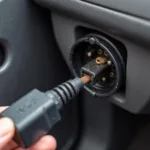Understanding your car’s health has never been easier, thanks to the advent of OBD2 code readers. These nifty devices, once exclusive to mechanics, are now readily available and user-friendly, empowering car owners to diagnose issues without needing a mechanic’s expertise. This guide delves into the world of CAN OBD2 code readers, simplifying their functionality and guiding you on how to use them effectively.
What is a CAN OBD2 Code Reader?
Before we dive into the ‘how-to,’ let’s understand what a CAN OBD2 code reader is. OBD stands for On-Board Diagnostics, a system incorporated in vehicles since 1996. This system acts as your car’s internal communication network, monitoring various systems and storing Diagnostic Trouble Codes (DTCs) when issues arise.
A CAN OBD2 code reader, then, is a tool that acts as a translator, allowing you to understand these DTCs. It plugs into your car’s OBD2 port (usually located under the steering wheel) and retrieves the stored codes, displaying them in an easy-to-understand format.
Why Should You Use an OBD2 Code Reader?
You might wonder why you need a code reader when the check engine light is there to signal a problem. While the check engine light is helpful, it’s pretty vague. It could mean anything from a loose gas cap to a more serious engine issue. An OBD2 code reader provides specific codes, like “P0420” (indicating a potential catalytic converter problem), giving you a clearer picture of what’s going on.
How to Use a CAN OBD2 Code Reader: A Step-by-Step Guide
Using a CAN OBD2 code reader is straightforward. Here’s a step-by-step guide to walk you through the process:
- Locate Your Car’s OBD2 Port: The OBD2 port is typically located under the dashboard on the driver’s side, often near the steering column.
- Turn Off Your Car: Ensure your car is turned off and the ignition is not engaged.
- Plug in the Code Reader: Insert the code reader firmly into the OBD2 port. You should hear a click when it’s securely connected.
- Turn the Ignition On: Turn your car’s ignition to the “on” position, but don’t start the engine. This powers up the code reader and allows it to communicate with your car’s computer.
- Follow On-Screen Instructions: The code reader will power on and guide you through the process. This may involve entering vehicle-specific information like the Vehicle Identification Number (VIN).
- Read and Record Codes: The code reader will scan your vehicle’s system for stored DTCs. Once the scan is complete, it will display the codes it found. Note down these codes; you can look them up online or refer to your code reader’s manual for their meanings.
- Clear the Codes: Most code readers have a “clear codes” function. This erases the stored codes from your car’s computer. Caution: Only clear codes after you’ve addressed the underlying issue.
- Recheck for Codes (Optional): After fixing the problem, you can rescan your car to ensure the code is gone.
Choosing the Right CAN OBD2 Code Reader
Navigating the world of OBD2 code readers can seem daunting with the plethora of options available. However, understanding your needs and the features of different readers can simplify the selection process.
- Basic Code Readers: For simple code reading and clearing, basic code readers are budget-friendly and get the job done.
- Advanced Code Readers: These offer additional features like live data streaming, allowing you to monitor your car’s sensors in real-time.
- Smartphone-Based Readers: These connect to your smartphone via Bluetooth, providing a user-friendly interface and often offering additional features like data logging and graphing.
Choosing the right code reader ultimately depends on your budget and how deeply you want to dive into your car’s diagnostics.
Common OBD2 Codes and Their Meanings
Here are some frequently encountered OBD2 codes and their general meanings. Remember, while these provide a starting point, the specific interpretation can vary depending on your car’s make and model:
- P0420: Potential catalytic converter problem
- P0300: Random/multiple cylinder misfire detected
- P0171: System too lean (Bank 1)
- P0442: Evaporative emission control system leak detected (small leak)
- P0101: Mass Air Flow (MAF) sensor performance problem
OBD2 Code Reader: A Powerful Tool for Car Owners
“An OBD2 code reader is like having a window into your car’s brain,” says John Smith, a seasoned automotive engineer. “It empowers car owners to understand their vehicles better and make informed decisions regarding maintenance and repairs.”
Indeed, understanding how to use a CAN OBD2 code reader can save you time, money, and potential headaches down the road. It puts you in the driver’s seat, literally, when it comes to your car’s health.
FAQs about CAN OBD2 Code Readers
1. Will using an OBD2 code reader void my car’s warranty?
No, using an OBD2 code reader will not void your car’s warranty. It simply reads data already present in your car’s computer.
2. Can I fix all car problems myself after diagnosing them with an OBD2 code reader?
While a code reader helps pinpoint the issue, not all car problems are DIY-friendly. Some require specialized tools or knowledge best left to mechanics.
3. How often should I use my OBD2 code reader?
It’s a good practice to scan your car for codes periodically, especially if your check engine light illuminates.
Need Help? We’re Here for You!
Have more questions about OBD2 code readers or need assistance choosing the right one for your needs? Don’t hesitate to reach out! Our team of car diagnostic experts is available 24/7 to assist you. Contact us via WhatsApp: +1(641)206-8880, or Email: [email protected].
Explore More:
- Kungfuren OBD2 Scanner Universal OBD2 Code Reader Car Automotive Check
- Best OBD2 Diagnostic 2018
- Ducato OBD2
We’re here to help you navigate the world of car diagnostics and keep your vehicle running smoothly!


